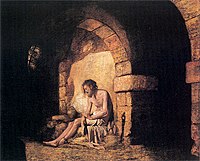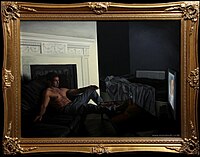
Laurence Sterne was an Anglo-Irish novelist and Anglican cleric who wrote the novels The Life and Opinions of Tristram Shandy, Gentleman and A Sentimental Journey Through France and Italy, published sermons and memoirs, and indulged in local politics. He grew up in a military family, travelling mainly in Ireland but briefly in England. An uncle paid for Sterne to attend Hipperholme Grammar School in the West Riding of Yorkshire, as Sterne's father was ordered to Jamaica, where he died of malaria some years later. He attended Jesus College, Cambridge on a sizarship, gaining bachelor's and master's degrees. While Vicar of Sutton-on-the-Forest, Yorkshire, he married Elizabeth Lumley in 1741. His ecclesiastical satire A Political Romance infuriated the church and was burnt.

The Life and Opinions of Tristram Shandy, Gentleman, also known as Tristram Shandy, is a novel by Laurence Sterne, inspired by Don Quixote. It was published in nine volumes, the first two appearing in 1759, and seven others following over the next seven years. It purports to be a biography of the eponymous character. Its style is marked by digression, double entendre, and graphic devices. The first edition was printed by Ann Ward on Coney Street, York.

John Raphael Smith was a British painter and mezzotinter. He was the son of Thomas Smith of Derby, the landscape painter, and father of John Rubens Smith, a painter who emigrated to the United States.

A Sentimental Journey Through France and Italy is a novel by Laurence Sterne, written and first published in 1768, as Sterne was facing death. In 1765, Sterne travelled through France and Italy as far south as Naples, and after returning determined to describe his travels from a sentimental point of view. The novel can be seen as an epilogue to the possibly unfinished work The Life and Opinions of Tristram Shandy, Gentleman, and also as an answer to Tobias Smollett's decidedly unsentimental Travels Through France and Italy. Sterne had met Smollett during his travels in Europe, and strongly objected to his spleen, acerbity and quarrelsomeness. He modelled the character of Smelfungus on him.
Journal to Eliza is a work by British author Laurence Sterne. It was published posthumously in 1904. It is written as a diary, but was supposedly intended as a love letter to Eliza Draper. Sterne predicted that it would be published long after the deaths of both himself and Draper.

Shandy Hall is a writer's house museum in the former home of the Rev. Laurence Sterne in Coxwold, North Yorkshire, England. Sterne lived there from 1760 to 1768 as perpetual curate of Coxwold. He is remembered for his novels The Life and Opinions of Tristram Shandy, Gentleman and A Sentimental Journey Through France and Italy.
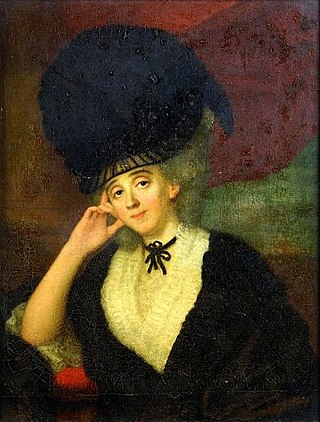
Eliza Draper is best known as Laurence Sterne's Eliza. She was his muse and is commemorated in his Sentimental Journey and Journal to Eliza. She had literary talents that were developed under Sterne's influence, and she wrote many long and interesting letters from India, vividly describing the life and customs there.

Yorick is an unseen character in William Shakespeare's play Hamlet. He is the dead court jester whose skull is exhumed by the First Gravedigger in Act 5, Scene 1, of the play. The sight of Yorick's skull evokes a reminiscence by Prince Hamlet of the man, who apparently played a role during Hamlet's upbringing:
Alas, poor Yorick! I knew him, Horatio; a fellow of infinite jest, of most excellent fancy; he hath borne me on his back a thousand times; and now, how abhorred in my imagination it is! My gorge rises at it. Here hung those lips that I have kissed I know not how oft. Where be your gibes now? Your gambols? Your songs? Your flashes of merriment, that were wont to set the table on a roar?
Sentimentalism is a practice of being sentimental, and thus tending towards making emotions and feelings the basis of a person's actions and reactions, as opposed to reason.

Johann Joachim Christoph Bode was a well-known German translator of literary works.

Richard Newton was an English caricaturist, miniaturist and book illustrator.
Vice Admiral Washington Shirley, 5th Earl Ferrers, FRS was a British Royal Navy officer, peer, freemason and amateur astronomer.
Thomas Hardy (1757–1804) was a portrait painter born in Derbyshire, England.

Adam Buck (1759–1833) was an Irish neo-classical portraitist and miniature painter and engraver principally active in London.
John Hall-Stevenson, in his youth known as John Hall, was an English country gentleman and writer.

The Captive King is a sketch by Joseph Wright of Derby completed in 1772 or 1773. It depicts the French nobleman Guy de Lusignan held prisoner by Saladin. The sketch is thought to have been a preparation for the now-lost painting Guy de Lusignan in Prison.
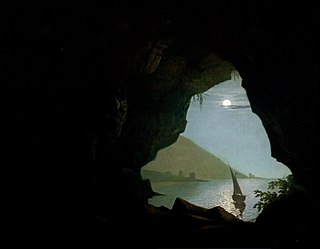
Grotto in the Gulf of Salerno is the subject of at least four paintings completed by Joseph Wright of Derby following his visit there in 1774. The paintings show the different lighting at different times of the day.
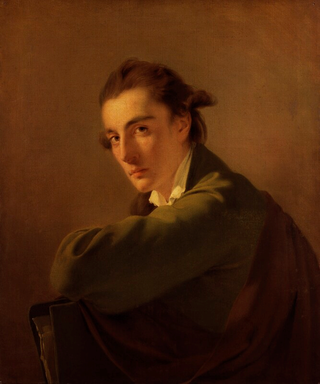
Richard Hurlstone or Richard Hurleston was a British portrait painter known for being a pupil of Joseph Wright of Derby. He went to Italy with Wright and his wife. He returned and died young after being hit by lightning on Salisbury Plain.

The Frog Service or Green Frog Service is a large dinner and dessert service made by the English pottery company Wedgwood for Empress Catherine the Great of Russia, and completed in 1774. The service had fifty settings, and 944 pieces were ordered, 680 for the dinner service and 264 for the dessert. At Catherine's request the hand-painted decoration showed British scenes, copied from prints, with a total of 1,222 views. In addition each piece had a green frog within a shield, a reference to the name of the palace it was intended for.

Thomas Gainsborough was the first British artist to employ cottages as a major subject, in what has become known as his "Cottage Door" paintings, painted during the final decades of his life; and was in the vanguard of a late 18th century fad of interest in them.

